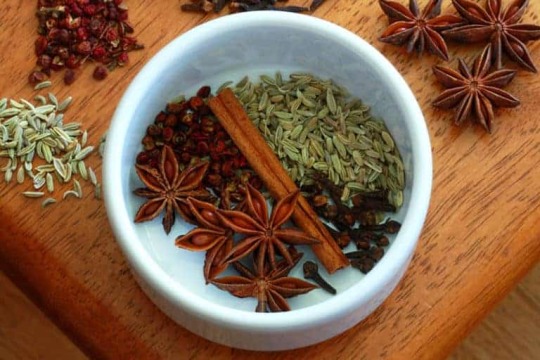#it also might be fun to do vocab lists for japanese/korean/vietnamese foods
Text
Spices in Chinese

In my totally unbiased opinion, one of the best things about learning Chinese has been learning about Chinese food culture. Chinese food uses a dizzying array of spices, but these are the most common that you'll see in recipes. Learning these words might even help you find your way around your local Asian grocery store!
The Basics:
鹽 (yán): salt
糖 (táng): sugar
- Not technically spices, but salt and sugar are essential seasonings in Chinese cooking. Sugar is often used to provide balance in savory dishes, especially in the food of certain regions such as Shanghai.
味精 (wèijīng): MSG
-MSG is also a common ingredient (but not really a spice), and not associated with the same racist health panic as in the US. Some chefs, however, see it as "cheating" and prefer to impart umami through traditional ingredients like dried mushrooms and high-quality stock.
粉 (fěn)/面 (miàn): powder
- These two words can be stuck to the end of the spices below to indicate that they are ground instead of whole.
Spice Mixes:
五香粉 (wǔxiāngfěn): five-spice powder
- A sweet-and-savory spice mix well known around the world, five-spice powder tends to include star anise, Sichuan peppercorn, cinnamon, fennel and cloves.
咖哩粉 (gālífěn): curry powder
- British colonization brought curry to Hong Kong, where it's popular with beef or fish balls.
燒烤料 (shāokǎoliào): barbecue spice mix
- This doesn't refer to char siu, but to the spicy grilled meat skewers that are popular across China. A typical version hailing from the north-west is based on cumin and chili powder.
Spices:
胡椒 (hújiāo): pepper
- Chinese makes use of both white pepper (白胡椒) and black pepper (黑胡椒), but white pepper is more common.
花椒 (huājiāo): Sichuan peppercorn
- This is the spice that gives Sichuan food its famous numbing quality, though it is used all across China as well. It comes in red or green varieties, and can be used fresh or dried.
辣椒 (làjiāo): chili pepper
- Spicy food is popular in Sichuan and the rest of China's southwest, where tons of chili varieties are used fresh and dry-- this alone could be material for an entire vocab list.
八角 (bājiǎo): star anise
- One of the most iconic spices in Chinese cuisine, its name literally means "eight horns". It's commonly tossed into stews and braises.
肉桂 (ròuguì)/桂皮 (guìpí): cinnamon
- The cinnamon commonly used in Chinese cuisine is in fact cassia, which is stronger-flavored but less aromatic.
丁香 (dīngxiāng): clove
- A key ingredient in five-spice powder and occasionally tossed into braises. Interestingly, many of the sweet spices that we associate with desserts in the US are not commonly used as such in Asia. A friend once told me that many Taiwanese people don't like cinnamon desserts because they find the taste medicinal.
茴香 (huíxiāng): anise seed
- This spice is featured in Lu Xun's story Kong Yiji, where Kong Yiji asks the young narrator if he can write the character 茴, which is used in the name of the tavern's peas with anise.
香葉 (xiāngyè): bay leaf
- Bay leaves are used in China in much the same way as in the US-- tossed into stews and braises to provide a little... well, nobody knows what a bay leaf tastes like but it must be doing something.
陳皮 (chénpí): aged tangerine peel
- American-Chinese classics like orange chicken are likely influenced by stir-fries made with this bitter and fragrant peel.
百荳蔻 (báidòukòu): white cardamom
- Chinese food doesn't use the green cardamom commonly used in Indian food, instead preferring to use white cardamom in braised dishes.
草果 (cǎoguǒ): black cardamom, tsao-ko
- Black cardamom is dried over a fire, giving it a distinctive smoky flavor. While not overly common in much of China, it is one of the most common seasonings used in Yunnan food.
孜然 (zīrán): cumin
- Cumin is also not a flavor commonly associated with China, but it's iconic of the food of China's northwest, such as Shaanxi and Xinjiang.
甘草 (gāncǎo): licorice root
沙姜 (shājiāng); sand ginger
當歸 (dāngguī): angelica root
- These three spices are all known for their uses in traditional Chinese medicine, but are also used in medicinal soups and larger spice mixes. There are, of course, way more TCM herbs and spices used in Chinese cooking, but these are the most common to see in recipes or dishes.
#chinese#mandarin chinese#langblr#studyblr#vocab lists#zbtg posts#food#can u guys tell how much i love food and cooking and spices#i'll probably make more lists like this in the future#definitely one for sauces#and maybe vegetables or fruits#or different types of tofu... or noodles...#it also might be fun to do vocab lists for japanese/korean/vietnamese foods#all pretty popular in taiwan at least so i could just google maps some restaurants from where i used to live and go to town
170 notes
·
View notes